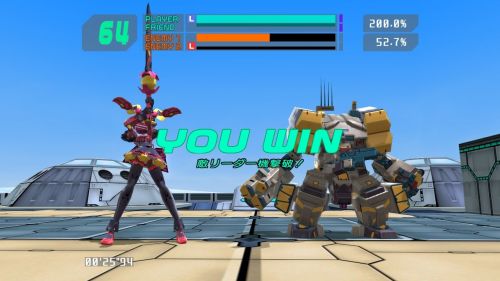Welcome to the latest edition of Co-Op International. Here I discuss co-op games that have not been released in the US. This will include current gen games as well as classics. We hope you’ll enjoy learning more about Japanese games – please let us know in the comments section!
In case the last three installments of Co-Op International haven’t clued you in, most of the import-only Xbox 360 games with co-op are shoot-em-ups. Given my love-hate relationship with the genre, I’ve been longing for something a little different. Enter SEGA’s Virtual-On Force - aka Cyber Troopers Virtual-On Force, but the console alphabetizes it under V so that’s what we’ll do too. The latest in the cult-favorite Virtual-On series, Force sadly never made its way to America. Thankfully it’s region-free and easy to import, so fans needn’t miss out on this installment.
Calling Force the latest Virtual-On is something of a misnomer. The arcade version actually debuted in Japanland way back in 2001. Two years later, the Playstation 2-exclusive sequel Virtual-On Marz followed, adding heaps of content but receiving tepid reviews. The series then slept for several more years (dreaming of electric sheep, presumably) before Force finally saw a mildly-upgraded Xbox 360 release in 2010. Virtual-On Force’s most important feature: four-player combat. Only the game isn’t every robot-for-himself. Rather, matches consist of two teams of two duking it out for mechanical supremacy.
Battling with a friend against AI enemies must have been an exciting experience in early-2000s arcades. SEGA wisely added 2-player split-screen co-op support to the 360 version’s Arcade Mode. Each player can choose their own Virtuaroid (the series’ version of mechs) and battle through 9 2-vs-2 and one 2-vs-1 matches together. One Virtuaroid on each team is designated the leader – if that bot goes down, the match ends. You can share some of your health with your partner (human or AI) by performing a Recovery Dash into him or her (Back button); reviving fallen partners works the same way.
A couple of caveats to local co-op: first, we had some difficulty creating a save file for my partner when he joined in. This was probably due to the menu’s heavy use of Japanese text and my poor skills in said language, but I can’t say for sure. As a workaround, my partner simply booted the game up on his own, created a save file, and received the game’s 20 GamerScore ‘gimme’ Achievement for doing so. After that, I relaunched the game, he pressed Start to join, and then chose his own save without issue.

The other, more distressing aspect of co-op is the split-screen size. Like Onechanbara Z: Kagura, each player’s screen takes up only one-fourth of the actual screen. The display reverts to full-screen at the end of a round as winners make their victory poses. Given that Virtual On Force’s graphics are extremely simplistic compared to modern games (despite the beautiful mech designs), the porting team certainly could have put more effort into expanding the field of view for 2-player mode. Still, being able to play together on the same system is much nicer than not having the option at all – especially since both players can earn Achievements!
Force doesn’t provide the wealth of content that Marz had, but the home version does at least extend its playtime by a few hours with the new Mission Mode. These two sets of 10 missions each (or four sets if we count DLC) play much like normal matches, but they mix things up with new objectives like collecting items or restrictions such as slower turn speed or no jumping. The actual mission descriptions appear in Japanese text, unfortunately, but you’ll find translations here. Completing missions also unlocks a wide variety of Virtuaroid variants.
